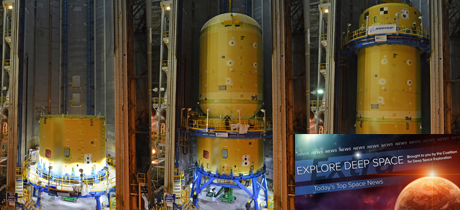In Today’s Deep Space Extra… Boeing and NASA worked to bring the scheduled completion date of Space Launch System (SLS) Core Stage back to the end of 2019. NASA’s SLS is a critical part of the nation’s human deep exploration future, writes on space historian. NASA’s Transiting Exoplanet Survey Satellite (TESS), launched a year ago this Thursday, has discovered its first Earth-sized extra solar planet. Retired NASA Skylab and space shuttle astronaut Owen Garriott has died.
Human Space Exploration
Boeing, NASA look to finish first SLS Core Stage by end of year
Coalition Member in the News – Boeing
NASASpaceflightnow.com (4/15): NASA and prime contractor Boeing have reworked the final assembly plan for the first Space Launch System (SLS) Core Stage to bring the scheduled completion date back to the end of 2019. With the engine section at the bottom of the rocket pacing the overall schedule into the middle of the year, changing the sequence of the last two major connections allows more work to be done on the rest of the rocket and reduces the list of tasks to complete when everything is joined together.
This is not the time to abandon NASA’s Space Launch System (SLS) – Op Ed
The Hill (4/15): The U.S. should not abandon NASA’s Space Launch System (SLS) heavy lift rocket in its bid to accelerate a human return to the surface of the Moon in 2024, four years sooner than previous planning and a goal outlined by Vice President Mike Pence, who chairs the White House National Space Council, on March 26. The SLS is being developed to work in concert with NASA’s Orion capsule, which is to launch and return astronauts from deep space destinations, writes Jonathan Ward, a space historian. A safe and sustainable return to the Moon currently depends on the SLS, he adds.
Apollo 11’s Mike Collins wants “JFK direct” to Mars
Spacepolicyonline.com (4/16): Among its April 15 news Tidbits, Spacepolicyonline.com summarizes a Monday evening interview at the National Press Club in Washington between Apollo 11 command module pilot Mike Collins and veteran newsman Marvin Kalb. Collins favors a “JFK” style direct push to reach Mars with human explorers, rather than a sustained return to the Moon by 2024 as a first step to Mars. The 2024 lunar return goal was called for by the White House in late March.
Skylab and space shuttle astronaut Owen Garriott dies at 88
NASA/Johnson Space Center (4/15): Retired NASA astronaut Owen Garriott, who participated in the Skylab 3 mission aboard NASA’s first space station in 1973, has died. Garriott, 88, died April 15 at his home in Huntsville, Alabama. Schooled as an electrical engineer, Garriott was selected by NASA for training as a scientist/astronaut in 1965 and would go on to launch a second time in late 1983 aboard the space shuttle Columbia on the Spacelab-1 mission. He was inducted into the U.S. Astronaut Hall of Fame in 2011.
Space Science
TESS finds its first Earth-sized planet
Physics.org (4/15): Scientists at the Carnegie Institution for Science have confirmed the discovery of the first Earth-sized planet by NASA’s Transiting Exoplanet Survey Satellite, or TESS, which was launched a year ago Thursday as a successor to the exo-planet seeking Kepler space telescope. The Earth sized planet and a sub Neptune class sibling planet discovered by TESS orbit a star 53 light years from the solar system. Findings were published Monday in the Astrophysical Journal Letters.
Scientists are trying to figure out why InSight’s “Mole” can’t dig any deeper
Universe Today (4/15): NASA’s Mars Insight lander landed successfully on the Red Planet November 26, 2018, on a mission to probe the planet’s subsurface processes from the crust down to the core. However, in late February a German science instrument engineered to pound into the subsurface to measure the planet’s internal heat flow was stalled by an obstruction, possibly a rock or gravel. Engineers working to overcome the obstacle are pursuing a turnaround for the heat probe with little data.
Other News
It’s time to speak out about India’s reckless anti satellite test – Op Ed
The Space Review (4/15): India acted unnecessarily on March 27 when it carried out a low altitude anti satellite weapons test that sent some impact debris higher than the orbit of the six person International Space Station (ISS), writes Jessica West, a senior researcher at Project Ploughshares, a Canadian peace and disarmament research organization. India is recognized as a rising global space power, and any assertion that the ASAT test was necessary to declare its standing was unnecessary, she writes.
Falcon Heavy core booster lost in rough seas after drone ship landing
Spaceflightnow.com (4/15): Last Thursday’s successful SpaceX Falcon Heavy launch with a communications satellite from NASA’s Kennedy Space Center (KSC) offered a spectacle as the side and core boosters returned to Earth. The two side boosters reached land and the core descended to an ocean going drone ship. The core stage, however, tipped on the drone ship after it touched down and was lost, SpaceX said Monday.
The Space Review (4/15): After a long wait, not unusual in the world of aerospace development, Stratolaunch, the world’s largest airplane took flight on Saturday from the Mojave Air and Spaceport in California for a successful test of the potential airborne launch platform carrying up to three rockets with payloads. But questions over whether it will find a market linger.

